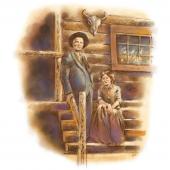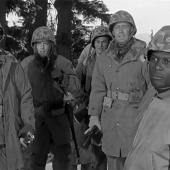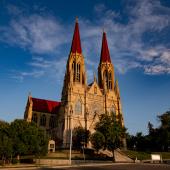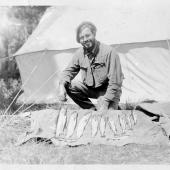Tales of the Belgrade Bull
Mentioning the famous Belgrade Bull can still prompt passionate debate, although it’s been over a century since that son of a milk cow dumped cowboys in the dirt. In addition to his alliterative name, the Belgrade Bull had other characteristics that made him a legend. He was gentle enough to walk placidly down a crowded parade route. But when a cowboy climbed on his back, he became a formidable bucking machine.
A Montana newspaperman described the bull, also known as Corbett, this way: “The bull throws his head around and gives the rider that sort of where-have-we-met before look. And while the victim yet gazes and guesses, Corbett gets his ‘beautiful curve.’ This sends the saddle and rider spinning. If the rider is not ‘sent to the grass’ by the first shock, he continues, constantly adding new and different variations while in mid air. Three, four, or five jumps usually does away with the most experienced rider.”
Pres Johnston, who managed Corbett during his exhibition days, said, “After he threw his rider, he would stop and come to me, as I would have a piece of bread or some biscuits for him. He liked them very much.”
When Corbett was a calf, children tried to ride him after Sunday school. The first person to take on Corbett as a mature bull was Frank Collins, who recalled his adventure decades later. Collins and two other teenagers decided to give the bull a try on Easter Sunday 1892. The boys drew straws, and Collins pulled the short one.
Collins recalled: “I stayed on him longer than anyone I ever saw try him. But of course I was not down astraddle of him all the time.
I was just riding the air up over him and clawing at every thing I could get a hold of, but finally I missed making good connections. I stood on my head out in front of him.”

Collins and his friends must have talked up the bull’s prowess because experienced riders became interested in him. That fall when a threshing crew arrived, a local bronco rider named Herbert Brady decided to give the bull a try. Collins put a halter on the bull and used a sack to blindfold him. Brady climbed aboard, and Collins pulled off the blindfold. Corbett snorted, and Brady sailed into the air landing with his stirrup between him and the saddle. Collins reported, “Herbert walked in wide order for a few days until he got healed up in places where the stirrup peeled him.”
Brady, an average rider, wanted Lou Kennedy, a more experienced man, to try the bull. But Kennedy took riding seriously and wouldn’t try it unless he could make some money. So Brady cooked up a scheme to fleece Kennedy.
He knew another excellent rider, Jack Flynn. He figured if Jack couldn’t ride the bull, Lou couldn’t either. Herbert persuaded Jack to try the bull so they would know if they should bet.
Herbert, Jack and some friends went out one bright moonlit night and found the bull running loose. He was so tame they had no trouble catching and saddling him. Jack looked at his watch and said, “Eleven o’clock, boys, just the right time to ride a bull.” Then he climbed into the saddle. On the third jump he flew into the air, and the men sent word to Lou Kennedy that they had money to bet.
Later that week after Sunday school, children rushed to join a crowd assembled to watch Lou ride. After Lou mounted he told his father to pull off Corbett’s blindfold. The bull gave a snort and sent Lou flying. He caught his pants on the saddled horn and tore them so badly he had to make for the tall grass and hide from the Sunday school crowd.
Lou’s ride convinced Pres Johnston that he could make money betting on the bull so he talked his brother, Al, into buying the animal. The Johnston brothers named the bull “Corbett” after the world heavy weight boxing champion and began taking bets on him on Sundays in Belgrade.
The first man to ride Corbett in Belgrade was Bill Sitton. Sitton used a double cinch that kept the bull from arching his back, so he couldn’t make his best jumps. The Johnstons then barred such equipment.
Next was John “Kid” Kelly from Fort Ellis. Kelly saddled the bull and signaled that he was ready. The man who was to remove the bull’s blindfold botched the job, so Corbett couldn’t see and ran into a nearby wagon that was used as a viewing stand. He crashed into the wagon, stopped and Kelly got off. The rules said only that a man had to ride until the bull stopped, so the Johnstons gave Kelly the $25 prize. Pres Johnston said it was the only time they ever paid.
Men began coming from miles away to win the cash, but Corbett bucked all of them off. The Bozeman Courier joked that the Johnston brothers made so much money betting on their bull they could start a bank or build a railroad.
In December 1893, the Bozeman Chronicle reported that a cowboy named “Starchy”successfully rode the bull. Apparently they were referring to George “Starkey” Teeples, who owned a ranch in Carbon County. Probably Teeples used stirrups tied together under the bull’s belly, which wasn’t allowed.
Corbett’s fame spread until he could draw a crowd wherever he went. His largest audience probably was at a July 4, 1894, celebration in Bozeman where 5,000 people came to watch him. It was difficult to find challengers, but finally two men named Sam Brumfield and John Foster tried and got themselves thrown.
In August, Corbett went to a Labor Day celebration in Anaconda. The Anaconda Standard said when Corbett came out, he “appeared so good natured and easy going and wore an expression of contentedness that applications to ride were made by several persons.” First up was Martin Johnson. Corbett balked at being saddled and wouldn’t let Johnson mount, so the man decided to drop onto the bull from above. When Johnson hit Corbett’s back, a man opened the chute. The bull jumped twelve feet into the air, arched his back and sent Johnson sprawling. Next was a man named John Brass who Corbett threw on the third jump.
Two weeks later Corbett went to Butte where he sent a man named Jim Radford into a full somersault and threw a man called “Mormon Ben” on the second jump. In six days, he was in Helena where local newspapers reported two men tried to ride him — and one succeeded. The Helena Herald said a cowboy from Fort Benton won a $200 prize for riding the bull, but Pres Johnston denied that.
Apparently because they had a hard time getting challengers, the Johnstons then sold Corbett to a Wild West show for $300. The show failed in Indiana, and the owners sold Corbett to a farmer. The famous Belgrade Bull lived out his days as a herd sire. Pres Johnston said nobody ever rode Corbett with a fair saddle, but some people still argue about that.











- Reply
Permalink